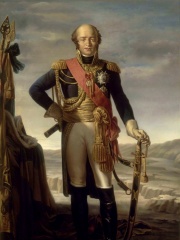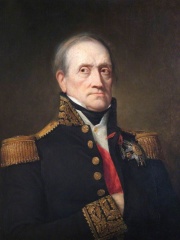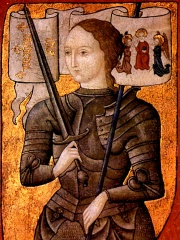
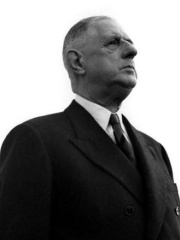
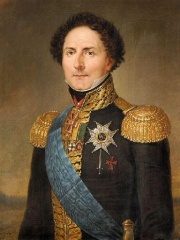
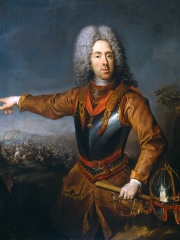
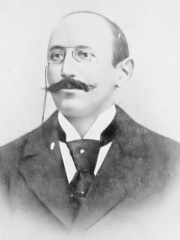
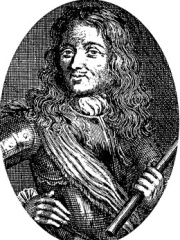
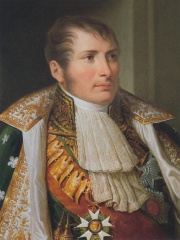
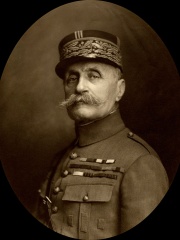
The Most Famous
MILITARY PERSONNELS from France
This page contains a list of the greatest French Military Personnels. The pantheon dataset contains 2,058 Military Personnels, 153 of which were born in France. This makes France the birth place of the 4th most number of Military Personnels behind United States, and Russia.
Top 10
The following people are considered by Pantheon to be the top 10 most legendary French Military Personnels of all time. This list of famous French Military Personnels is sorted by HPI (Historical Popularity Index), a metric that aggregates information on a biography's online popularity. Visit the rankings page to view the entire list of French Military Personnels.

1. Joan of Arc (1412 - 1431)
With an HPI of 91.02, Joan of Arc is the most famous French Military Personnel. Her biography has been translated into 154 different languages on wikipedia.
Joan of Arc (French: Jeanne d'Arc [ʒan daʁk] ; Middle French: Jehanne Darc [ʒəˈãnə ˈdark]; c. 1412 – 30 May 1431) is a patron saint of France, honored as a defender of the French nation for her role in the siege of Orléans and her insistence on the coronation of Charles VII of France during the Hundred Years' War. Claiming to be acting under divine guidance, she became a military leader who gained recognition as a savior of France. Joan was born to a propertied peasant family at Domrémy in northeast France. In 1428, she requested to be taken to Charles VII, later testifying that she was guided by visions from the archangel Michael, Saint Margaret, and Saint Catherine to help him save France from English domination. Convinced of her devotion and purity, Charles sent Joan, who was about seventeen years old, to Orléans as part of a relief army. She arrived at the city in April 1429, wielding her banner and bringing hope to the demoralized French army. Nine days after her arrival, the English abandoned the siege. Joan encouraged the French to aggressively pursue the English during the Loire Campaign, which culminated in another decisive victory at Patay, opening the way for the French army to advance on Reims unopposed, where Charles was crowned as the king of France with Joan at his side. These victories boosted French morale, paving the way for their final triumph in the Hundred Years' War several decades later. After Charles's coronation, Joan participated in the unsuccessful siege of Paris in September 1429 and the failed siege of La Charité in November. Her role in these defeats reduced the court's faith in her. In early 1430, Joan organized a company of volunteers to relieve Compiègne, which had been besieged by the Burgundians—French allies of the English. She was captured by Burgundian troops on 23 May. After trying unsuccessfully to escape, she was handed to the English in November. She was put on trial by Bishop Pierre Cauchon on accusations of heresy, which included blaspheming by wearing men's clothes, acting upon visions that were demonic, and refusing to submit her words and deeds to the judgment of the church. She was declared guilty and burned at the stake on 30 May 1431, aged about nineteen. In 1456, an inquisitorial court reinvestigated Joan's trial and overturned the verdict, declaring that it was tainted by deceit and procedural errors. Joan has been described as an obedient member of the Catholic Church, an early feminist, and a symbol of freedom and independence. She is popularly revered as a martyr. After the French Revolution, she became a national symbol of France. In 1920, Joan of Arc was canonized by Pope Benedict XV and, two years later, was declared one of the patron saints of France. She is portrayed in numerous cultural works, including literature, music, paintings, sculptures, and theater.

2. Charles de Gaulle (1890 - 1970)
With an HPI of 86.70, Charles de Gaulle is the 2nd most famous French Military Personnel. His biography has been translated into 169 different languages.
Charles André Joseph Marie de Gaulle (22 November 1890 – 9 November 1970) was a French general and statesman who led the Free French Forces against Nazi Germany and Vichy France in World War II and chaired the Provisional Government of the French Republic from 1944 to 1946 to restore democracy in France. Following the Algiers putsch, he came out of retirement at the request of President René Coty, who appointed him Prime Minister. He commissioned a new constitution which was approved by voters in a referendum, establishing the Fifth Republic. He was subsequently elected President of France later that year, a position he held until his resignation in 1969. He is widely considered the greatest Frenchman of the 20th century. Born in Lille, he was a decorated officer of World War I, wounded several times and taken prisoner of war by the Germans. During the interwar period, he advocated mobile armoured divisions. During the German invasion of May 1940, he led an armoured division that counterattacked the invaders; he was then appointed Undersecretary for War. Refusing to accept his government's armistice with Germany, de Gaulle fled to England and exhorted the French to continue the fight in his Appeal of 18 June. He led the Free French Forces and later headed the French National Liberation Committee and emerged as the undisputed leader of Free France. He became head of the Provisional Government of the French Republic in June 1944, the interim government of France following its liberation. As early as 1944, de Gaulle introduced a dirigiste economic policy, which included substantial state-directed control over a capitalist economy, which was followed by 30 years of unprecedented growth, known as the Trente Glorieuses. He resigned in 1946, but continued to be politically active as founder of the Rally of the French People. He retired in the early 1950s and wrote his War Memoirs, which quickly became a staple of modern French literature. When the Algerian War threatened to bring the unstable Fourth Republic to collapse, the National Assembly brought him back to power during the May 1958 crisis. He founded the Fifth Republic with a strong presidency; he was elected with 78% of the vote to continue in that role. He managed to keep France together while taking steps to end the war, much to the anger of the Pieds-Noirs (ethnic Europeans born in Algeria) and the armed forces. He granted independence to Algeria and acted progressively towards other French colonies. In the context of the Cold War, de Gaulle initiated his "politics of grandeur", asserting that France as a major power should not rely on other countries, such as the United States, for its national security and prosperity. To this end, he pursued a policy of "national independence" which led him to withdraw from NATO's integrated military command and to launch an independent nuclear strike force which made France the world's fourth nuclear power. He restored cordial France–Germany relations with Konrad Adenauer to create a European counterweight between the Anglo-American and Soviet spheres of influence through the signing of the Élysée Treaty on 22 January 1963. De Gaulle opposed any development of a supranational Europe, favouring Europe as a continent of sovereign nations. De Gaulle openly criticised the US intervention in Vietnam and the exorbitant privilege of the US dollar. In his later years, his support for the slogan "Vive le Québec libre" and his two vetoes of Britain's entry into the European Economic Community generated considerable controversy in both North America and Europe. Although reelected to the presidency in 1965, he faced widespread protests by students and workers in May 68 but had the Army's support and won a snap election with an increased majority in the National Assembly. De Gaulle resigned in 1969 after losing a referendum in which he proposed more decentralisation. He died a year later at the age of 79, leaving his presidential memoirs unfinished. Many French political parties and leaders claim a Gaullist legacy; many streets and monuments in France and other parts of the world were dedicated to his memory after his death.

3. Charles XIV John of Sweden (1763 - 1844)
With an HPI of 82.94, Charles XIV John of Sweden is the 3rd most famous French Military Personnel. His biography has been translated into 70 different languages.
Charles XIV John (Swedish: Karl XIV Johan; 26 January 1763 – 8 March 1844) was King of Sweden and Norway from 1818 until his death in 1844 and the first monarch of the Bernadotte dynasty. In Norway, he is known as Charles III John (Norwegian: Karl III Johan); before he became royalty in Sweden, his name was Jean-Baptiste Jules Bernadotte. During the Napoleonic Wars, he participated in several battles as a Marshal of France. Born in Pau in the region of southern France known as Béarn, Bernadotte joined the French Royal Army in 1780. Following the outbreak of the French Revolution, he demonstrated great military talent, rising rapidly through the ranks and becoming a brigadier general by 1794. He served with distinction in Italy and Germany, and was briefly Minister of War. His relationship with Napoleon was turbulent; nevertheless, Napoleon named him a Marshal of the Empire on the proclamation of the French Empire. Bernadotte played a significant role in the French victory at Austerlitz, and was made Prince of Pontecorvo as a reward. His marriage to Désirée Clary, whose sister was married to Joseph Bonaparte, made Bernadotte a member of the extended Imperial family. In 1810, Bernadotte was unexpectedly elected the heir-presumptive (Crown Prince) to the childless King Charles XIII of Sweden, thanks to the advocacy of Baron Carl Otto Mörner, a Swedish courtier and obscure member of the Riksdag of the Estates. He assumed the name Charles (Carl) after his adoptive father and John (Johan), which is a Swedish version of Jean. He was subsequently named regent and generalissimo of the Swedish Armed Forces, soon after his arrival becoming de facto head of state for most of his time as Crown Prince. In 1812, following the sudden unprovoked French invasion of Swedish Pomerania, Crown Prince Charles John was instrumental in the creation of the Sixth Coalition by allying with Alexander I of Russia and using Swedish diplomacy to bring warring Russia and Britain together in alliance. He then played a major role in the writing of the Trachenberg Plan, the war-winning Allied campaign plan, and commanded the Allied Army of the North that defeated two concerted French attempts to capture Berlin and made the decisive attack on the last day of the catastrophic French defeat at Leipzig. Following the conclusion of the Leipzig campaign and after liberating Bremen and Lübeck from the French in late November 1813, Charles John invaded Denmark, aiming to knock Napoleon's last major ally out of the war to secure the Coalition's northern flank in preparation for the invasion of France in 1814 and to secure Norway for Sweden, as stipulated in the several treaties that created the Sixth Coalition. After a brief campaign that saw the defeat of the Danish Army, King Frederick VI of Denmark was forced to sign the Treaty of Kiel on 15 January 1814 that ceded Norway to Sweden, that in turn led to the Swedish–Norwegian War of 1814, where Norway was defeated in nineteen days. This put Norway into a union with Sweden, which lasted for almost a century before its peaceful 1905 dissolution. The Swedish–Norwegian war is viewed as Sweden's last direct conflict and war. Upon the death of Charles XIII in 1818, Charles John ascended to the throne. He presided over a period of peace and prosperity, and reigned until his death in 1844.

4. Prince Eugene of Savoy (1663 - 1736)
With an HPI of 82.21, Prince Eugene of Savoy is the 4th most famous French Military Personnel. His biography has been translated into 64 different languages.
Prince Eugene Francis of Savoy-Carignano (18 October 1663 – 21 April 1736), better known as Prince Eugene, was a distinguished feldmarschall in the Army of the Holy Roman Empire and of the Austrian Habsburg dynasty during the 17th and 18th centuries. Renowned as one of the greatest military commanders of his era, Prince Eugene also rose to the highest offices of state at the Imperial court in Vienna, spending six decades in the service of three emperors. Born in Paris, to the son of a French count and a niece of Cardinal Mazarin, Eugene was raised at the court of King Louis XIV. Initially destined for the priesthood as the youngest son of a noble family, he chose to pursue a military career at 19. Due to his poor physique and possibly a scandal involving his mother, Louis XIV denied him a commission in the French Royal Army and forbade him from enlisting elsewhere. Embittered, Eugene fled France and entered the service of Emperor Leopold I, cousin and rival of Louis XIV, in whose service his elder brother Louis Julius had just fallen in battle. At 20, Prince Eugene of Savoy distinguished himself during the Ottoman siege of Vienna in 1683. Commanding troops at Budapest (1686) and Belgrade (1688), he became a field marshal by age 25. In the Nine Years' War, he fought alongside his distant cousin, the Duke of Savoy. As commander-in-chief in Hungary, Eugene's decisive victory at the Battle of Zenta (1697) ended the Ottoman threat for nearly 20 years. During the War of the Spanish Succession (1701–1714), he served Emperor Leopold I, achieving victories in Italy and forming a crucial partnership with the Duke of Marlborough, securing wins at Blenheim (1704), Oudenaarde (1708), and Malplaquet (1709). His success continued in Italy, notably at Turin (1706). Renewed Austro-Turkish conflicts saw Eugene triumph at Petrovaradin (1716) and Belgrade (1717), solidifying his legacy as one of Europe's greatest military commanders and securing peace in 1718. Throughout the late 1720s, Eugene's diplomatic skills secured powerful allies for the Emperor in dynastic struggles with the Bourbon powers. Physically and mentally fragile in his later years, Eugene saw less success as commander-in-chief during the War of the Polish Succession (1733–1735). Despite his opposition to the conflict, he loyally led a defensive campaign, preventing enemy invasion of Bavaria. During his peaceful years, Eugene accumulated a vast collection of art and literature and corresponded with contemporary artists, scientists, and philosophers. His architectural legacy includes Baroque palaces like the Belvedere in Vienna. He died on 21 April 1736, aged 72.
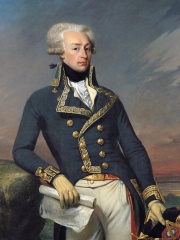
5. Gilbert du Motier, Marquis de Lafayette (1757 - 1834)
With an HPI of 82.19, Gilbert du Motier, Marquis de Lafayette is the 5th most famous French Military Personnel. His biography has been translated into 62 different languages.
Marie-Joseph Paul Yves Roch Gilbert du Motier, Marquis de La Fayette (French: [ʒilbɛʁ dy mɔtje maʁki d(ə) la fajɛt]; 6 September 1757 – 20 May 1834), known in the United States as Lafayette (), was a French military officer and politician who volunteered to join the Continental Army, led by General George Washington, in the American Revolutionary War. Lafayette commanded Continental Army troops in the decisive siege of Yorktown in 1781, the Revolutionary War's final major battle, which secured American independence. After returning to France, Lafayette became a key figure in the French Revolution of 1789 and the July Revolution of 1830 and continues to be celebrated as a hero in both France and the United States. Lafayette was born into a wealthy land-owning family in Chavaniac in the province of Auvergne in south-central France. He followed the family's martial tradition and was commissioned an officer at age 13. He became convinced that the American revolutionary cause was noble, and he traveled to the New World seeking glory in it. He was made a major general at age 19 but was initially not given American troops to command. He fought with the Continental Army at the Battle of Brandywine near Chadds Ford, Pennsylvania, where he was wounded but organized an orderly retreat, and he served with distinction in the Battle of Rhode Island. In the middle of the war, he returned home to France to lobby for an increase in French support for the American Revolution. He returned to America in 1780 and was given senior positions in the Continental Army. In 1781, troops under his command in Virginia blocked a British army led by Lord Cornwallis until other American and French forces could position themselves for the decisive siege of Yorktown. Lafayette returned to France and was appointed to the Assembly of Notables in 1787, convened in response to the fiscal crisis. He was elected a member of the Estates General of 1789, where representatives met from the three traditional orders of French society: the clergy, the nobility, and the commoners. After the National Constituent Assembly was formed, he helped to write the Declaration of the Rights of Man and of the Citizen with Thomas Jefferson's assistance. This document was inspired by the United States Declaration of Independence, which was authored primarily by Jefferson, and invoked natural law to establish basic principles of the democratic nation-state. He also advocated the abolition of slavery, in keeping with the philosophy of natural rights. After the storming of the Bastille, he was appointed commander-in-chief of France's National Guard and tried to steer a middle course through the years of revolution. In August 1792, radical factions ordered his arrest, and he fled to the Austrian Netherlands. He was captured by Austrian troops and spent more than five years in prison. Lafayette returned to France after Napoleon Bonaparte secured his release in 1797, though he refused to participate in Napoleon's government. After the Bourbon Restoration of 1814, he became a liberal member of the Chamber of Deputies, a position which he held for most of the remainder of his life. In 1824, President James Monroe invited him to the United States as the nation's guest, where he visited all 24 states in the union and met a rapturous reception. During France's July Revolution of 1830, he declined an offer to become the French dictator. Instead, he supported Louis-Philippe as king, but turned against him when the monarch became autocratic. He died on 20 May 1834 and is buried in Picpus Cemetery in Paris, under soil from Bunker Hill. He is sometimes known as "The Hero of the Two Worlds" for his accomplishments in the service of both France and the United States.

6. Alfred Dreyfus (1859 - 1935)
With an HPI of 77.76, Alfred Dreyfus is the 6th most famous French Military Personnel. His biography has been translated into 64 different languages.
Alfred Dreyfus (9 October 1859 – 12 July 1935) was a French Army officer best known for his central role in the Dreyfus affair. In 1894, Dreyfus fell victim to a judicial conspiracy that eventually sparked a major political crisis in the French Third Republic when he was wrongfully accused and convicted of being a German spy due to antisemitism. Dreyfus was arrested, cashiered from the French army and imprisoned on Devil's Island in French Guiana. Eventually, evidence emerged showing that Dreyfus was innocent and the true culprit was fellow officer Ferdinand Walsin Esterhazy. Gradual revelations indicated that the internal investigation conducted by the French army was biased; Dreyfus was an ideal scapegoat due to being a Jew, and military authorities were aware of his innocence but chose to cover up the affair and leave him imprisoned rather than lose face. A political scandal subsequently erupted, shaking French political life and highlighting antisemitism in the French army and government. After numerous judicial and political developments, the publication of Émile Zola's manifesto J'Accuse...! in 1898 brought new momentum to Dreyfus' cause. Zola accused French military and political leadership of covering up the affair. Dreyfus was eventually exonerated, rehabilitated and reinstated in the French army, although at a lower rank than his seniority would have warranted. "Anti-Dreyfusards" and antisemites in France, however, viewed even his incomplete rehabilitation unfavorably, and while attending the transfer of Zola's remains to the Panthéon, Dreyfus was the target of an unsuccessful assassination attempt by an antisemitic militarist who was later acquitted at trial. Dreyfus later fought in World War I, notably at the battles of Verdun and the Aisne, before retiring and leading a quiet life. He died in 1935 in Paris and was buried in the Montparnasse Cemetery. Dreyfus' life and the antisemitic persecutions he endured left a significant mark on French political consciousness, while Esterhazy remained unpunished until his death. Among Dreyfus’s defenders were writers such as Zola, Charles Péguy, and Anatole France, politicians such as Georges Clemenceau and Jean Jaurès, filmmakers such as Georges Méliès, and the founders of the Human Rights League (LDH) Francis de Pressensé and Pierre Quillard.

7. Charles de Batz de Castelmore d'Artagnan (1611 - 1673)
With an HPI of 77.24, Charles de Batz de Castelmore d'Artagnan is the 7th most famous French Military Personnel. His biography has been translated into 38 different languages.
Charles de Batz de Castelmore (French pronunciation: [ʃaʁl də bats də kastɛlmɔʁ]), also known as d'Artagnan and later Count d'Artagnan (c. 1611 – 25 June 1673), was a French musketeer who served Louis XIV as captain of the Musketeers of the Guard. He died at the siege of Maastricht in the Franco-Dutch War. A fictionalised account of his life by Gatien de Courtilz de Sandras formed the basis for the d'Artagnan Romances of Alexandre Dumas père, most famously including The Three Musketeers (1844). The heavily fictionalised version of d'Artagnan featured in Dumas' works and their subsequent screen adaptations is now far more widely known than the real historical figure.

8. Eugène de Beauharnais (1781 - 1824)
With an HPI of 77.01, Eugène de Beauharnais is the 8th most famous French Military Personnel. His biography has been translated into 44 different languages.
Eugène Rose de Beauharnais (French: [øʒɛn d(ə) boaʁnɛ]; 3 September 1781 – 21 February 1824) was a French statesman and military officer who served in the French Revolutionary and Napoleonic Wars. Through the second marriage of his mother, Joséphine de Beauharnais, he was the stepson of Napoleon Bonaparte. Under the French Empire, he also became Napoleon's adopted son (but not the heir to the imperial throne). He was Viceroy of the Kingdom of Italy under his stepfather, from 1805 to 1814, and commanded the Army of Italy during the Napoleonic Wars. Historians consider him one of Napoleon's most able relatives.

9. Ferdinand Foch (1851 - 1929)
With an HPI of 76.63, Ferdinand Foch is the 9th most famous French Military Personnel. His biography has been translated into 57 different languages.
Ferdinand Foch ( FOSH, French: [fɛʁdinɑ̃ fɔʃ]; 2 October 1851 – 20 March 1929) was a French general, Marshal of France and a member of the Académie Française and Académie des Sciences. He distinguished himself as Supreme Allied Commander on the Western Front during the First World War in 1918. A commander during the First Marne, Flanders and Artois campaigns of 1914–1916, Foch became Supreme Allied Commander in late March 1918 in the face of the all-out German spring offensive. He successfully coordinated the French, British and American efforts, deftly handling his strategic reserves. He stopped the German offensive and launched a war-winning counterattack. In November 1918, Marshal Foch accepted the German cessation of hostilities and was present at the Armistice of 11 November 1918. At the outbreak of war in August 1914, Foch's XX Corps participated in the brief invasion of Germany before retreating in the face of a German counter-attack and successfully blocking the Germans short of Nancy. Ordered west to defend Paris, Foch's prestige soared as a result of the victory at the Marne, for which he was widely credited as a chief protagonist while commanding the French Ninth Army. He was then promoted again to assistant commander-in-chief for the Northern Zone, a role which evolved into command of Army Group North, and in which role he was required to cooperate with the British forces at Ypres and the Somme. At the end of 1916, partly owing to the disappointing results of the latter offensive and partly owing to wartime political rivalries, Foch was transferred to Italy. After being named the commander-in-chief of Western Front with the title Généralissime, Foch was appointed "Commander-in-Chief of the Allied Armies" on 26 March 1918. He played a decisive role in halting a renewed German advance on Paris in the Second Battle of the Marne, after which he was promoted to Marshal of France. Author Larry H. Addington says, "to a large extent the final Allied strategy which won the war on land in Western Europe in 1918 was Foch's alone." On 11 November 1918, Foch accepted the German request for an armistice. Foch advocated peace terms that would make Germany unable to pose a threat to France ever again. He considered the Treaty of Versailles too lenient on Germany. Winston Churchill attributed this famous but apocryphal quote about the Peace Treaty of Versailles to Foch: "This is not Peace. It is an Armistice for twenty years." Indeed, the next war broke out 20 years later.
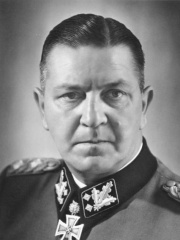
10. Theodor Eicke (1892 - 1943)
With an HPI of 74.40, Theodor Eicke is the 10th most famous French Military Personnel. His biography has been translated into 36 different languages.
Theodor Eicke (17 October 1892 – 26 February 1943) was both a senior SS functionary and a Waffen-SS divisional commander in Nazi Germany. He was a key figure in the development of Nazi concentration camps. Eicke served as the second commandant of the Dachau concentration camp from June 1933 to July 1934, and together with his adjutant Michael Lippert, was one of the executioners of SA Chief Ernst Röhm during the Night of the Long Knives purge of 1934. He continued to expand and develop the concentration camp system as the first Concentration Camps Inspector. In 1939, Eicke became commander of the SS Division Totenkopf of the Waffen-SS, leading the division during the Second World War on the Western and Eastern fronts. Eicke was killed on 26 February 1943, when his plane was shot down during the Third Battle of Kharkov.
People
Pantheon has 153 people classified as French military personnels born between 105 BC and 1973. Of these 153, none of them are still alive today. The most famous deceased French military personnels include Joan of Arc, Charles de Gaulle, and Charles XIV John of Sweden.
Deceased French Military Personnels
Go to all RankingsJoan of Arc
1412 - 1431
HPI: 91.02
Charles de Gaulle
1890 - 1970
HPI: 86.70
Charles XIV John of Sweden
1763 - 1844
HPI: 82.94
Prince Eugene of Savoy
1663 - 1736
HPI: 82.21
Gilbert du Motier, Marquis de Lafayette
1757 - 1834
HPI: 82.19
Alfred Dreyfus
1859 - 1935
HPI: 77.76
Charles de Batz de Castelmore d'Artagnan
1611 - 1673
HPI: 77.24
Eugène de Beauharnais
1781 - 1824
HPI: 77.01
Ferdinand Foch
1851 - 1929
HPI: 76.63
Theodor Eicke
1892 - 1943
HPI: 74.40
Louis-Nicolas Davout
1770 - 1823
HPI: 74.15
Jean-de-Dieu Soult
1769 - 1851
HPI: 74.12
Overlapping Lives
Which Military Personnels were alive at the same time? This visualization shows the lifespans of the 25 most globally memorable Military Personnels since 1700.

